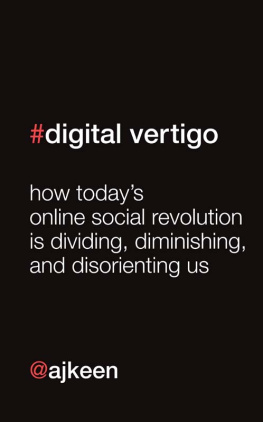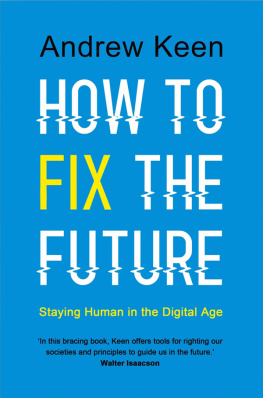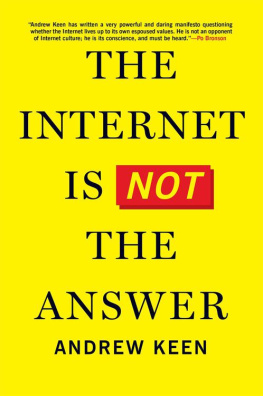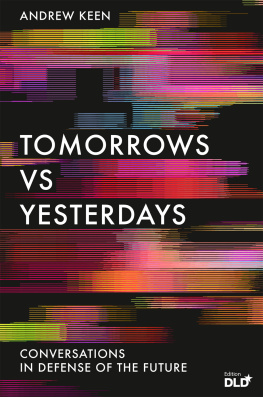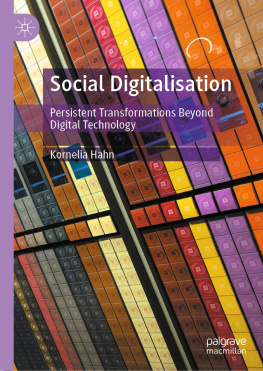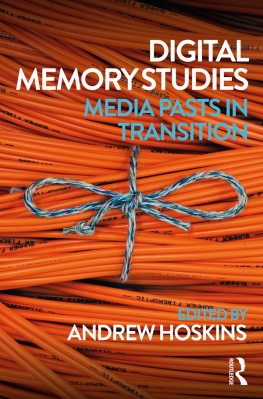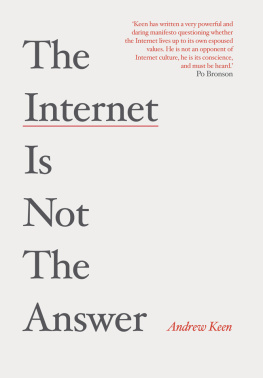ALSO BY ANDREW KEEN
The Cult of the Amateur: How Todays Internet Is Killing Our Culture

Constable & Robinson
5556 Russell Square
London WC1B 4HP
www.constablerobinson.com
First published in the USA by St Martins Press, 2012
First published in the UK by Constable, an imprint of Constable & Robinson Ltd., 2012
Copyright Andrew Keen, 2012
The right of Andrew Keen to be identified as the author of this work has been asserted by her in accordance with the Copyright, Designs and Patents Act 1988.
All rights reserved. This book is sold subject to the condition that it shall not, by way of trade or otherwise, be lent, re-sold, hired out or otherwise circulated in any form of binding or cover other than that in which it is published and without a similar condition including this condition being imposed on the subsequent purchaser.
A copy of the British Library Cataloguing in Publication Data is available from the British Library.
ISBN 978-1-78033-840-8 (paperback)
ISBN 978-1-78033-841-5 (ebook)
Printed and bound in the UK
1 3 5 7 9 10 8 6 4 2
For MK and HK
CONTENTS
Hello hello/Im at a place called Vertigo/Its everything I wish I didnt know
U2, Vertigo (2004)
On one occasion she asked if I was a journalist or writer. When I said that neither the one nor the other was quite right, she asked what it was that I was working on, to which I replied that I did not know for certain myself, but had a growing suspicion that it might turn into a crime story...
W. G. Sebald, Vertigo (1990)
One final thing I have to do and then Ill be free of the past.... One doesnt often get a second chance. I want to stop being haunted. Youre my second chance, Judy. Youre my second chance.
Alec Coppel and Samuel A. Taylor, Vertigo (1958)
INTRODUCTION
HYPERVISIBILITY
@alexia: We would have lived our lives differently if we had known they would one day be searchable.
A Man Who Is His Own Image
Alfred Hitchcock, who always referred to movies as pictures, once said that behind every good picture lay a great corpse. Hitchcock, an old master at resurrecting the dead in pictures like Vertigo, his creepy 1958 movie about a mans love affair with a corpse, was right. The truth is a great corpse makes such a good picture that it can even help bring a nonfiction book like this to life.
Behind this book sits the most visible corpse of the nineteenth centurythe body of the utilitarian philosopher, social reformer and prison architect Jeremy Bentham, a cadaver that has been living in public since his death in June 1832.
His greed for attention is today on permanent exhibition inside a public coffin whose size, Brave New World author Aldous Huxley once estimated, is now therefore never alone. He has, so to speak, eliminated his own loneliness.
The idea behind this book first came to life in that London corridor. There I serendipitously found myself one recent drizzly November afternoon, a Research In Motion (RIM) BlackBerry smartphone in the other, looking at the Auto-Icon. But the longer I stared at the creepy Jeremy Bentham imprisoned inside his fame machine, the more I suspected that our identities had, in fact, merged. You see, like the solitary utilitarian whod been on public display throughout the industrial age, Id become little more than a corpse on perpetual display in a transparent box.
Yes, like Jeremy Bentham, Id gone somewhere else entirely. I was in a place called social media, that permanent self-exhibition zone of our new digital age where, via my BlackBerry Bold and the other more than 5 billion devices now in our hands,
Crouching in front of the mahogany Auto-Icon, I adjusted the lens of my camera upon Bentham, zooming in so that I could intimately inspect his beady eyes, the wide brimmed tan hat covering his shoulder length gray hair, the white ruffled shirt and black rustic jacket clothing his dissected torso, and Dapple resting in his gloved hand. Shifting my camera toward his waxen face, I looked the dead Englishman as closely in the eye as my prying technology would allow. I was searching for the private man behind the public corpse. What, I wanted to know, had led The Hermit of Queens Square Place, to prefer the eternal glare of public exposure over the everlasting privacy of the grave?
In my other hand I held my BlackBerry Bold, RIMs pocket-sized device that, by broadcasting my location, my observations and my intentions to my electronic network, enabled me to perpetually live in public. My social media obligations nagged at me. As a Silicon Valley based networker, my jobboth then and nowis grabbing other peoples attention on Twitter and Facebook so that I can become ubiquitous. I am an influencer, a wannabe Jeremy Benthamwhat futurists call a Super Nodethe vanguard of the workforce that, they predict, will increasingly come to dominate the twenty-first-century digital economy. So that afternoon, like every afternoon in my reputation-building life, I really needed to be the picture on everyones screen.
Not that anyone, either on or off my social network, knew my exact location that November afternoon. I happened to be in central London for a few hours, in transit between one social media conference in Oxford that had just finished and another that would begin the following afternoon in Amsterdam, near the Rijksmuseum, the art museum that houses many of the most timeless pictures of the human condition by Dutch seventeenth-century artists like Johannes Vermeer and Rembrandt van Rijn.
But, in London, my interest lay in the living metropolis, what the Anglo-American writer Jonathan Raban calls the soft city of permanent personal reinvention, rather than in pictures by dead artists. It was my day off from the glare of public speaking, my opportunity to briefly escape from society and be left alone in a city where Id been born and educated but no longer lived. As the nineteenth-century German sociologist Georg Simmel wrote, the city grants to the individual a kind and an amount of personal freedom which has no analogy whatever under any other conditions. My illegibility that afternoon thus represented my liberty. Freedom meant nobody knowing exactly where I was.
To live in a city is to live in a community of people who are strangers to each other, writes Raban about the freedom of living in a large city. And Id certainly spent that chilly November afternoon as a stranger lost amidst a community of disconnected strangers, zigzagging through Londons crooked streets, hopping on and off buses and trains, stopping here and there to re-explore familiar places, reminding myself about how the city had imprinted itself on my personality.
Eventually, as so often one does while wandering through London, I happened to find myself in the Bloomsbury neighborhood where, some thirty years earlier, I had attended university as a student of modern history. There, I strolled through Senate Housethe forbiddingly monolithic building which had housed my college and which was the model, it is said, for George Orwells Ministry of Truth in Nineteen Eighty-fourbefore wandering up Gower Street toward Jeremy Benthams corpse in University College.
@Quixotic
I had come to London that morning from Oxford, where Id spent the previous few days at a conference entitled Silicon Valley Comes to Oxford. This was an event organized by the universitys Said Business School in which Silicon Valleys most influential entrepreneurs had come to the closed, haunted city of Oxford to celebrate the openness and transparency of social life in the twenty-first century.

